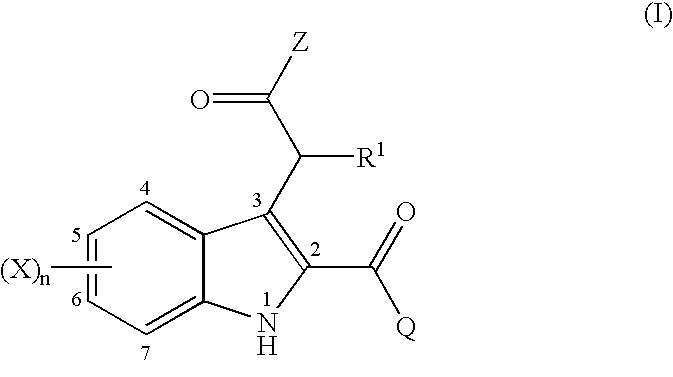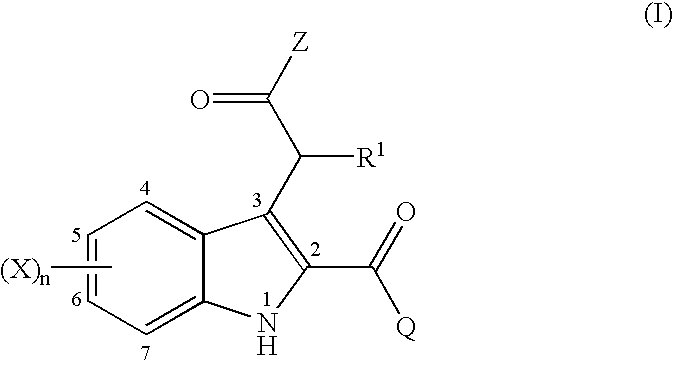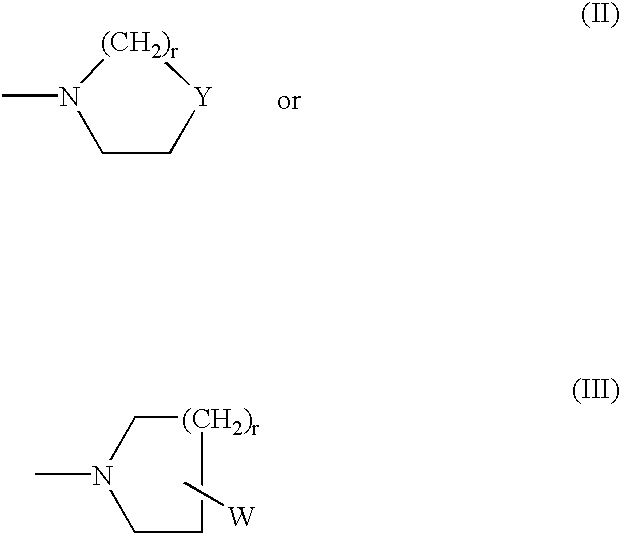2,3-substituted indole compounds as anti-inflammatory and analgesic agents
a technology of indole and substituted indole, which is applied in the direction of heterocyclic compound active ingredients, biocide, drug compositions, etc., can solve the problems of limited therapeutic use of conventional nsaids, severe side effects, etc., and achieve the effect of inhibiting the contraction of prostaniod
- Summary
- Abstract
- Description
- Claims
- Application Information
AI Technical Summary
Benefits of technology
Problems solved by technology
Method used
Image
Examples
example 1
Ethyl(2-benzoyl-6-chloro-1H-indol-3-yl)acetate
Step 1. Ethyl trans-4-Chloro-2-nitrocinnamate
To a suspension of sodium hydride (60% w / w dispersion in mineral oil, 4.4 g, 0.11 mol) in THF (150 ml) was added dropwise a solution of triethyl phosphonoacetate (25.0 g, 0.11 mol) in THF (50 ml) at room temperature. After stirring for 1 h. a solution of 4-chloro-2-nitrobenzaldehyde (19.0 g, 0.10 mol) in THF (50 ml) was added. After stirring for an additional 1 h, saturated aqueous ammonium chloride (50 ml) was added and the resulting mixture was extracted with ethyl acetate (300 ml.times.2). The combined organic extracts were dried (MgSO.sub.4) and concentrated to gave 27 g (quant.) of the title compound as brown solids.
.sup.1 H-NMR (CDCl.sub.3) .delta.: 8.04 (1H, d, J=15.8 Hz), 8.03 (1H, d, J=1.8 Hz), 7.64-7.58 (2H, m), 6.36 (1H, d, J=15.8 Hz), 4.30 (2H, q, J=7.0 Hz), 1.35 (3H, t, J=7.0 Hz).
Step 2. Ethyl trans-2-Amino-4-chlorocinnamate
A mixture of ethyl trans-4-chloro-2-nitrocinnamate (step ...
example 2
(2-Benzoyl-6-chloro-1H-indol-3-yl)acetic Acid
Method A
To a solution of ethyl(2-benzoyl-6-chloro-1H-indol-3-yl)acetate (Example 1, 380 mg, 0.11 mmol) in ethanol (15 ml) was added 2N aqueous KOH (5 ml). After heating at 80.degree. C. for 1 h, the mixture was cooled and concentrated, and then 2N aqueous HCl (15 ml) added carefully. The mixture was extracted with diethyl ether (50 ml.times.2), the combined organic extracts dried (MgSO.sub.4) and concentrated. The residual solids were recrystallized from ethyl acetate / hexane to afford 60 mg (17%) of the title compound as pale yellow solids.
m.p.: 183-186.degree. C. IR (KBr) .nu.: 1700, 1610, 1520, 1425, 1330, 1000 cm.sup.-1. .sup.1 H-NMR (DMSO-d.sub.6) .delta.: 12.26 (1H, br s), 11.76 (1H, s), 7.77-7.66 (4H, m), 7.62-7.54 (2H, m), 7.48 (1H, d, J=1.8 Hz), 7.13 (1H, dd, J=1.8, 8.7 Hz), 3.80 (2H, s).
Method B
Step 1. 6-Chloro-1-(phenylsulfonyl)indole
A mixture of 6-chloroindole (Y. Watanabe et al., J. Org. Chem., 1990, 55, 580, 36.2 g, 0.24 mol)...
example 3
(2-Benzoyl-6-chloro-1H-indol-3-yl)acetic Acid, Sodium Salt
(2-Benzoyl-6-chloro-1H-indol-3-yl)acetic acid (Example 2, 480 mg, 1.5 mmol) in ethanol (10 ml) was treated with 2N aqueous NaOH (0.7 ml, 1.4 mmol) at room temperature for 30 min. and then concentrated. The residue was dissolved in water (10 ml) and washed with diethyl ether (15 ml.times.2). The aqueous layer was concentrated to afford 350 mg (68%) of the title compound as pale brown solids.
m.p.: 185-189.degree. C. IR (KBr) .nu.: 1523, 1380, 1230, 1060, 1004, 918 cm.sup.-1. .sup.1 H-NMR (DMSO-d.sub.6) .delta.: 11.46 (1H, br s), 7.88-7.84 (21H, m), 7.66 (1H, d, J=8.4 Hz), 7.64-7.46 (3H, m), 7.39 (1H, d, J=1.8 Hz), 7.00 (1H, dd, J=1.8, 8.4 Hz), 3.32 (2H, s).
PUM
| Property | Measurement | Unit |
|---|---|---|
| temperature | aaaaa | aaaaa |
| temperature | aaaaa | aaaaa |
| temperature | aaaaa | aaaaa |
Abstract
Description
Claims
Application Information
 Login to View More
Login to View More - R&D
- Intellectual Property
- Life Sciences
- Materials
- Tech Scout
- Unparalleled Data Quality
- Higher Quality Content
- 60% Fewer Hallucinations
Browse by: Latest US Patents, China's latest patents, Technical Efficacy Thesaurus, Application Domain, Technology Topic, Popular Technical Reports.
© 2025 PatSnap. All rights reserved.Legal|Privacy policy|Modern Slavery Act Transparency Statement|Sitemap|About US| Contact US: help@patsnap.com



